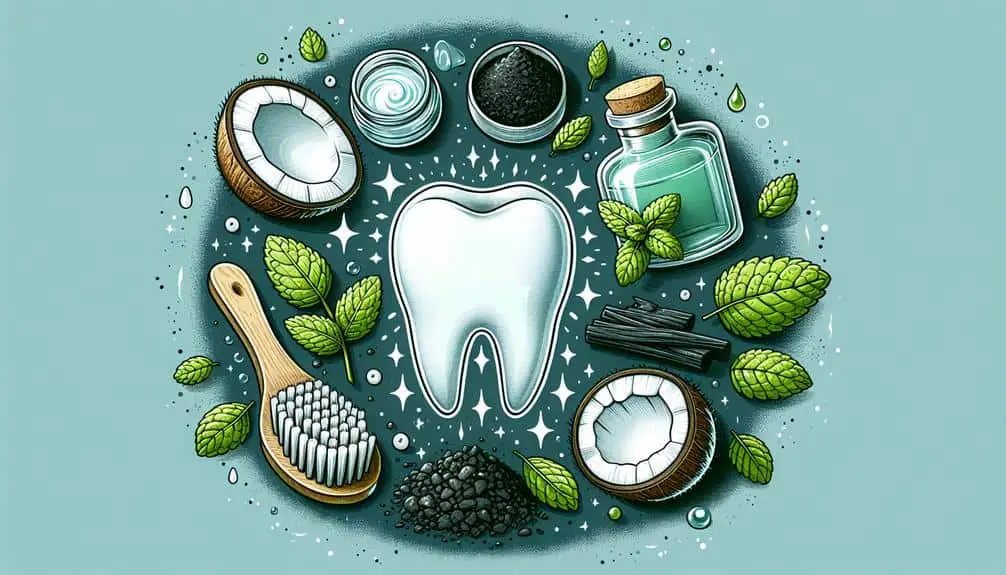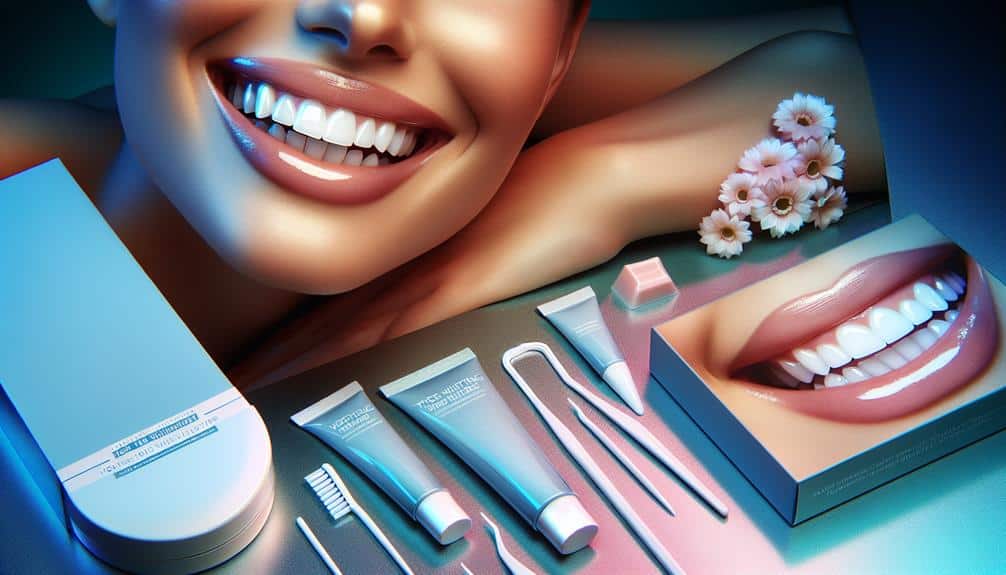To safeguard your enamel with organic whitening gel, choose products with natural ingredients like baking soda and essential oils that are gentle yet effective. Ethically sourced gels with proven efficacy and recyclable packaging guarantee a sustainable approach to teeth whitening. Apply the gel gently using a 45-degree brush angle and circular motion to cover all tooth surfaces while avoiding enamel erosion from overuse. Prioritize enamel health post-whitening with a diet rich in calcium and vitamins and incorporate fluoride for strengthening. Remember, these tips provide a foundation for enamel protection, with more strategies available to enhance your smile further.
Key Points
- Choose organic whitening gels with natural ingredients for enamel safety.
- Follow recommended frequency to avoid enamel erosion and sensitivity.
- Maintain enamel health with a balanced diet and fluoride oral care.
- Prioritize sustainable brands with proven efficacy for enamel protection.
- Consult a dentist for personalized enamel protection strategies post-whitening.
Benefits of Organic Whitening Gel
When considering the benefits of using organic whitening gel, you'll discover a safe and effective solution for enhancing your smile while protecting your enamel. Opting for natural alternatives like organic whitening gel provides you with eco-friendly options that are free from harsh chemicals commonly found in traditional whitening products. These natural ingredients work gently on your teeth, ensuring a brighter smile without compromising the health of your enamel.
Organic whitening gel often contains ingredients like baking soda, activated charcoal, and essential oils that not only whiten your teeth but also promote overall oral health. These ingredients help to remove surface stains effectively while being gentle on your enamel, preventing any damage or sensitivity. Unlike many conventional whitening products, organic whitening gel offers a more sustainable approach to teeth whitening, making it a preferred choice for those seeking a natural and eco-friendly solution.
Choosing the Right Organic Gel
To select the most suitable organic gel for whitening your teeth effectively, consider examining the list of ingredients for best results. When choosing the right organic whitening gel, keep in mind the following key factors:
- Ingredient Sourcing: Opt for gels that use ethically sourced and natural ingredients. Look for components like activated charcoal, coconut oil, or baking soda, known for their whitening properties without harsh chemicals.
- Product Effectiveness: Prioritize gels with proven efficacy in whitening teeth. Check for ingredients like hydrogen peroxide or carbamide peroxide within the recommended safe levels for effective whitening results.
- Environmental Impact: Choose gels from brands committed to sustainability and eco-friendly practices. Consider products packaged in recyclable materials to reduce environmental impact.
- Consumer Preferences: Take into account your personal preferences, such as flavor options, consistency of the gel, and any specific requirements like sensitivity issues. Select a gel that aligns with your preferences for a comfortable whitening experience.
Application Techniques for Enamel Protection
When applying organic whitening gel to protect your enamel, make sure you hold your toothbrush at a proper angle to reach all surfaces effectively.
Use a gentle massaging motion rather than aggressive scrubbing to prevent enamel damage.
Proper Brush Angle
For optimal enamel protection, ensure that the brush angle is approximately 45 degrees towards the gum line during application. This position allows for efficient cleaning while minimizing enamel wear and gum irritation. To confirm you're using the correct technique to safeguard your enamel, follow these tips:
- Angle Matters: Keep the brush at a 45-degree angle to the gum line.
- Gentle Pressure: Apply light pressure to prevent enamel damage.
- Circular Motion: Utilize a soft circular motion to clean effectively.
- Cover Each Tooth: Make sure you address all surfaces of each tooth for thorough cleaning.
Gentle Massaging Motion
Make sure to maintain a gentle massaging motion while applying the organic whitening gel to safeguard your enamel effectively. Use a toothbrush with soft bristles and apply the gel in a circular motion for best results.
This technique helps distribute the whitening gel evenly across your teeth while minimizing the risk of enamel damage. By gently massaging the gel onto your teeth, you can guarantee that the whitening ingredients reach all areas without causing unnecessary abrasion to the enamel.
The circular motion also aids in dislodging surface stains and plaque, promoting a thorough whitening effect. Remember, a soft bristle toothbrush combined with a gentle massaging motion is key to protecting your enamel while achieving a brighter smile.
Avoid Aggressive Scrubbing
To safeguard your enamel effectively while administering the organic whitening gel, avoid aggressive scrubbing techniques that may lead to unnecessary damage. Gentle care is crucial for preserving enamel protection during the whitening process. Here are some tips to help you achieve this:
- Use a gentle-bristled toothbrush: Choose a toothbrush with gentle bristles to prevent harsh actions on the enamel.
- Apply gentle pressure: Refrain from applying too much force while brushing to prevent enamel erosion.
- Circular movements: Brush in mild, circular movements to guarantee even distribution of the whitening gel without causing harm.
- Limit scrubbing duration: Avoid excessive scrubbing; a gentle approach over an adequate period is more beneficial for enamel health.
Frequency of Whitening Gel Use
Maintain peak enamel protection by incorporating the whitening gel into your oral care routine at a vital frequency. When using whitening gel, it's essential to prioritize safety. Always follow the instructions provided with the product to avoid potential risks to your enamel and gums. The frequency of whitening gel use plays an essential role in achieving desired results without compromising oral health. To strike a balance between effectiveness and safety, it's recommended to wait at least 24 to 48 hours between applications. This waiting period allows your enamel to remineralize and prevents overexposure to the whitening agents, reducing the risk of sensitivity or damage to the enamel.
Consistency is key when it comes to incorporating whitening gel into your routine. Aim for a schedule that aligns with the product's guidelines to optimize results while safeguarding your enamel. Overusing whitening gel can lead to enamel erosion and increased tooth sensitivity. By following the recommended frequency of use, you can enjoy a brighter smile while maintaining the health of your enamel.
Understanding Organic Ingredients
Understanding the role of organic ingredients in whitening gel formulations is essential for making informed choices about your oral care products. When it comes to natural ingredients in whitening gels, here are some key points to take into account:
- Enamel Care: Natural ingredients like baking soda and coconut oil are gentle on enamel, helping to maintain its strength and integrity during the whitening process.
- Antibacterial Properties: Some organic ingredients, such as tea tree oil or neem extract, possess antibacterial properties that can help in preventing oral infections and maintaining oral health.
- Anti-inflammatory Effects: Ingredients like aloe vera or chamomile not only soothe the gums but also have anti-inflammatory effects, promoting overall oral health.
- Nutrient-Rich Formulations: Organic whitening gels often contain ingredients rich in vitamins and minerals like vitamin C or calcium, which can support enamel remineralization and strengthen teeth.
Maintaining Enamel Health Post-Whitening
After whitening your teeth with organic whitening gel, ensuring the ongoing health of your enamel is essential to maintaining a bright and healthy smile. Diet plays a vital role in maintaining enamel health post-whitening. Consuming foods high in sugar and acids can contribute to enamel erosion. Opt for a balanced diet rich in calcium, phosphorus, and vitamins to support enamel remineralization and overall dental health.
Additionally, incorporating fluoride into your oral care routine can provide significant benefits. Fluoride helps strengthen enamel, making it more resistant to acid attacks that can lead to decay. Consider using fluoride toothpaste or mouthwash as recommended by your dentist to help protect your enamel post-whitening.
Professional Advice for Enamel Protection
To protect your enamel effectively, seek professional guidance from your dentist on personalized strategies for enamel protection. Here are some key points to keep in mind when discussing enamel protection with your dentist:
- Enamel Reinforcement: Your dentist may suggest specific toothpaste or mouthwash containing fluoride or calcium to help fortify your enamel.
- Regular Dental Exams: Make sure you schedule regular dental check-ups to monitor the health of your enamel and address any issues promptly.
- Tailored Mouthguards: If you grind your teeth at night, your dentist may recommend wearing a custom mouthguard to prevent enamel wear.
- Nutritional Advice: Your dentist can offer guidance on enamel-friendly diet choices and caution against foods and drinks that may harm your enamel.
Frequently Asked Questions
Can Organic Whitening Gel Be Used on Sensitive Teeth?
Yes, organic whitening gel can be used on sensitive teeth. The natural ingredients in the gel are gentle on enamel and designed to minimize tooth sensitivity. It's a safe option for protecting enamel while achieving a whiter smile.
Is Organic Whitening Gel Safe for Pregnant Women?
Organic whitening gel ingredients should be checked for safety during pregnancy. Consult your healthcare provider to confirm it's safe for you. Some ingredients might not be suitable during this time. Prioritize the health of you and your baby.
Can Organic Whitening Gel Be Used on Children's Teeth?
Using organic whitening gel on children's enamel is safe when done cautiously. Check for age restrictions and make sure it's fluoride-free. Prioritize their dental health by consulting a pediatric dentist for guidance on the best products.
How Long Does It Take to See Results With Organic Whitening Gel?
To see results with organic whitening gel, apply it consistently as directed. Most people notice a difference within two weeks of regular use. For best outcomes, adhere to the recommended application frequency and duration.
Are There Any Side Effects Associated With Using Organic Whitening Gel?
When using organic whitening gel, potential risks like tooth sensitivity or gum irritation may occur. Long term effects could include enamel damage if not used correctly. Consult a dentist for personalized advice.



